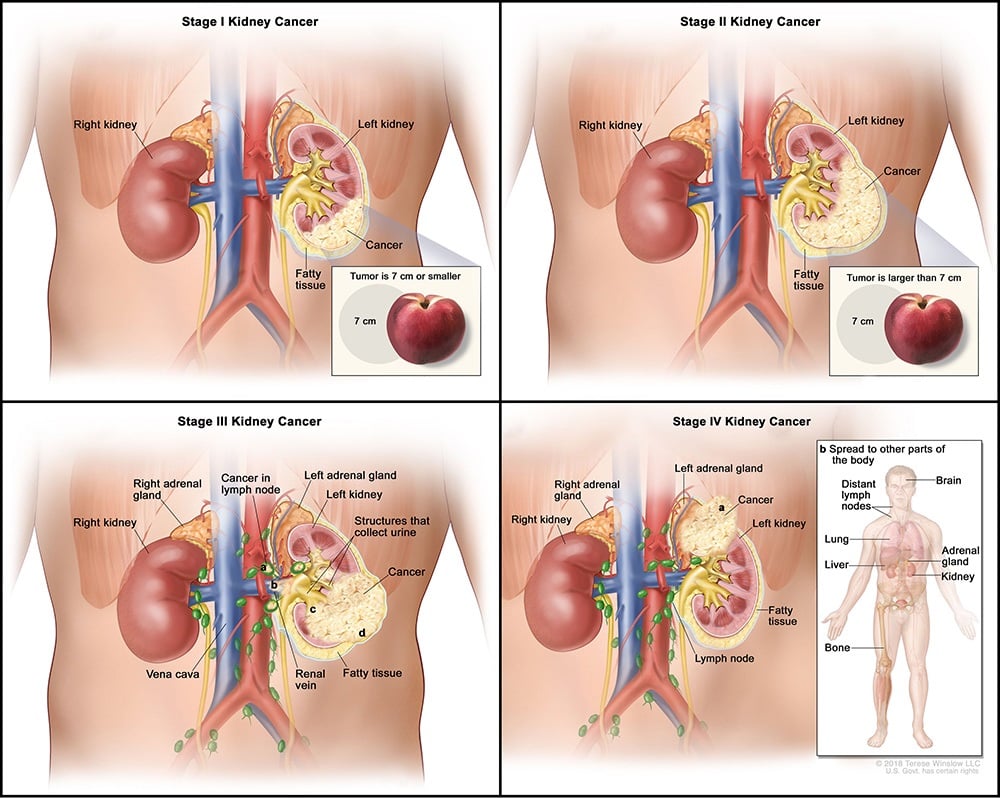Kidney Cancer

Kidney cancer is a cancer that forms in tissues of the kidneys. Kidney cancer includes renal cell carcinoma (cancer that forms in the lining of very small tubes in the kidney that filter the blood and remove waste products) and renal pelvis carcinoma (cancer that forms in the center of the kidney where urine collects). It also includes Wilms tumor, which is a type of kidney cancer that usually develops in children under the age of 5.
Visit the National Cancer Institute where this information and more can be found about Kidney Cancer or ask your cancer care team questions about your individual situation.
Lo que usted necesita saber sobre el cáncer de riñón en español.
Diagnosis
If you have symptoms that suggest kidney cancer, your doctor will try to find out what’s causing the problems.
You May Have A Physical Exam. Also, You May Have One Or More Of The Following Tests:
- Urine tests: The lab checks your urine for blood and other signs of disease.
- Blood tests: The lab checks your blood for several substances, such as creatinine. A high level of creatinine may mean the kidneys aren’t doing their job.
- Ultrasound: An ultrasound device uses sound waves that can’t be heard by humans. The sound waves make a pattern of echoes as they bounce off organs inside your abdomen. The echoes create a picture of your kidney and nearby tissues. The picture can show a kidney tumor.
- CT scan: An x-ray machine linked to a computer takes a series of detailed pictures of your abdomen. You may receive an injection of contrast material so your urinary tract and lymph nodes show up clearly in the pictures. The CT scan can show cancer in the kidneys, lymph nodes, or elsewhere in the abdomen.
- MRI: A large machine with a strong magnet linked to a computer is used to make detailed pictures of your urinary tract and lymph nodes. You may receive an injection of contrast material. MRI can show cancer in your kidneys, lymph nodes, or other tissues in the abdomen.
- IVP: You’ll receive an injection of dye into a vein in your arm. The dye travels through the body and collects in your kidneys. The dye makes them show up on x-rays. A series of x-rays then tracks the dye as it moves through your kidneys to your ureters and bladder. The x-rays can show a kidney tumor or other problems. (IVP is not used as commonly as CT or MRI for the detection of kidney cancer.)
- Biopsy: The removal of tissue to look for cancer cells is a biopsy. In some cases, your doctor will do a biopsy to diagnose kidney cancer. Your doctor inserts a thin needle through your skin into the kidney to remove a small sample of tissue. Your doctor may use ultrasound or a CT scan to guide the needle. A pathologist uses a microscope to check for cancer cells in the tissue.
- Surgery: After surgery to remove part or all of a kidney tumor, a pathologist can make the final diagnosis by checking the tissue under a microscope for cancer cells.
Staging
If kidney cancer is diagnosed, your doctor needs to learn the extent (stage) of the disease to help you choose the best treatment. The stage is based on the size of the kidney tumor and whether the cancer has invaded nearby tissues or spread to other parts of the body.
Your Doctor May Order One Or More Tests:
- Blood tests: Your doctor can check for substances in your blood. Some people with kidney cancer have high levels of calcium or LDH. A blood test can also show how well your liver is working.
- Chest x-ray: An x-ray of the chest can show a tumor in your lung.
- CT scan: CT scans of your chest and abdomen can show cancer in your lymph nodes, lungs, or elsewhere.
- MRI: MRI can show cancer in your blood vessels, lymph nodes, or other tissues in the abdomen.
When cancer spreads from its original place to another part of the body, the new tumor has the same kind of abnormal cells and the same name as the primary (original) tumor. For example, if kidney cancer spreads to a lung, the cancer cells in the lung are actually kidney cancer cells. The disease is metastatic kidney cancer, not lung cancer. It’s treated as kidney cancer, not as lung cancer.
These Are The Stages Of Kidney Cancer:
- Stage I: The tumor is no bigger than a tennis ball (almost 3 inches or about 7 centimeters). Cancer cells are found only in the kidney.
- Stage II: The tumor is bigger than a tennis ball. But cancer cells are found only in the kidney.
- Stage III: The tumor can be any size. It has spread to at least one nearby lymph node. Or it has grown through the kidney to reach nearby blood vessels.
- Stage IV: The tumor has grown through the layer of fatty tissue and the outer layer of fibrous tissue that surrounds the kidney. Or cancer cells have spread to nearby lymph nodes or to the lungs, liver, bones, or other tissues.

Treatment Options
Common treatment options for people with kidney cancer are surgery, targeted therapy, and biological therapy. You may receive more than one type of treatment.
The treatment that’s right for you depends mainly on the following:
- The size of the tumor
- Whether the tumor has invaded tissues outside the kidney
- Whether the tumor has spread to other parts of the body
- Your age and general health
Surgery
Surgery is the most common treatment for people with kidney cancer. The type of surgery depends on the size and stage of the cancer, whether you have two kidneys, and whether cancer was found in both kidneys.
You and your surgeon can talk about the types of surgery and which may be right for you:
- Removing all of the kidney (radical nephrectomy): The surgeon removes the entire kidney along with the adrenal gland and some tissue around the kidney. Some lymph nodes in the area may also be removed.
- Removing part of the kidney (partial nephrectomy): The surgeon removes only the part of the kidney that contains the tumor. People with a kidney tumor that is smaller than a tennis ball may choose this type of surgery.
There are two approaches for removing the kidney. The surgeon may remove the tumor by making a large incision into your body (open surgery). Or the surgeon may remove the tumor by making small incisions (laparoscopic surgery). The surgeon sees inside your abdomen with a thin, lighted tube (a laparoscope) placed inside a small incision.
The surgeon may use other methods of destroying the cancer in the kidney. For people who have a tumor smaller than 4 centimeters and who can’t have surgery to remove part of the kidney because of other health problems, the surgeon may suggest:
- Cryosurgery: The surgeon inserts a tool through a small incision or directly through the skin into the tumor. The tool freezes and kills the kidney tumor.
- Radiofrequency ablation: The surgeon inserts a special probe directly through the skin or through a small incision into the tumor. The probe contains tiny electrodes that kill the kidney cancer cells with heat.
Targeted Therapy
People with kidney cancer that has spread may receive a type of drug called targeted therapy. Many kinds of targeted therapy are used for kidney cancer. This treatment may shrink a kidney tumor or slow its growth.Usually, the targeted therapy is taken by mouth. You may want to read the NCI fact sheet Targeted Cancer Therapies.
Biological Therapy
People with kidney cancer that has spread may receive biological therapy. Biological therapy for kidney cancer is a treatment that may improve the body’s natural defense (the immune system response) against cancer. The treatments used for kidney cancer can slow the growth of tumors or shrink them. The biological therapy is injected intravenously or under the skin. The treatment may be given at the hospital or a doctor’s office.